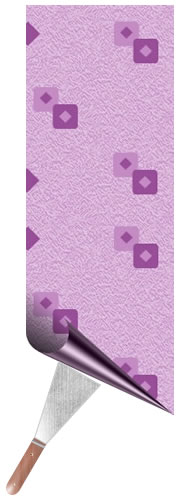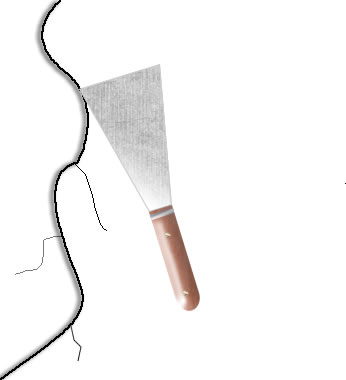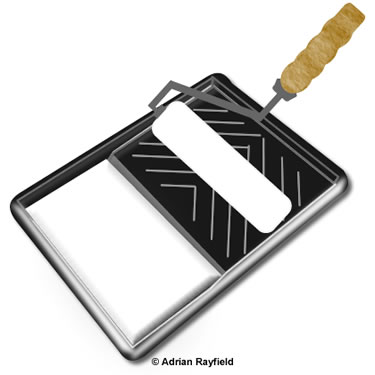Painting, decorating and home improvement tips blog
How to strip wallpaper
Posted by Adrian
May 2nd, 2010

How to strip wallpaper, and not take off half the wall with it!
At sometime or another wallpaper has to be removed from walls or ceilings, this could be due to many reasons but mostly because it’s faded, old and out-dated.
Knowing how to remove paper without taking off half the plaster with it is important and could save you a load of work and money.
Many people think they will simply go and hire a wallpaper stripper and an hour later all the wallpaper will be off, it’s not as simple as that.
You can save yourself money and not hire a wallpaper stripper just yet, you may not need one, firstly try the old fashioned method.
To start, gather the equipment needed.
You will need:
- Dustsheets – to cover the floor and furniture
- A scraper – to remove wallpaper
- A bucket – Filled with water
- A step ladder – Optional
- A paste brush or a large brush – To wet the wall
Firstly you need to remove the top layer of the wallpaper, with most papers you can remove the top layer as they are peelable, start in a corner by lifting the paper with your scraper and remove the top layer.
By removing the top layer you leave the backing paper behind, don’t be tempted to leave this on and either paint it or paper over it. The backing paper can bubble or lift as you paint or stick the new paper over it.
Tags: Decorating, Filling, Strippiing Wallpaper, Wallpaper, Wallpaper Steamer, Wallpaper stripping
Posted in Decorating Tips | 5 Comments »
How to fill cracks
Posted by Adrian
April 20th, 2010

How to fill crack to walls and ceilings
As many of you know who have done decorating before, preparation is key. Filling holes and cracks, and finishing them well, gives a far better finish. This is a how to guide on filling cracks. These can be on interior or exterior walls or ceilings, the principle is the same.
To start, gather the equipment needed.
You will need:
- Dustsheets – To cover floor and furniture
- A scraper – To apply filler
- Sand/Glass paper – To rub down dried filler
- A dusting brush – This could be a 3 inch brush
- Powder filler – To fill the crack
- PVA sealer – Optional
A quick note before you get started, decorators caulk is not suitable for filling these type of cracks, decorators caulk cannot be rubbed down and is only meant for gaps such as those around skirting boards and door frames.
Firstly you need to open up the crack slightly to enable filler to be applied. Use the edge of the scraper and run it down the crack, your aim is to make a ‘V’ shape by opening both sides of the crack.
Tags: Decorator Caulk, Filler
Posted in Decorating Tips | 1 Comment »
How to paint a ceiling
Posted by Adrian
April 11th, 2010

How to paint a ceiling
To start gather all the equipment needed
You will need:
- Dustsheets – To cover floor and furniture
- A brush – 1½ or 2 inch
- A roller cage – for the roller sleeve to go onto
- A roller sleeve – for smooth and lightly textured artexed ceilings use a fine or medium pile roller, ideally a 9-inch sleeve, for heavily artexed ceilings a long pile roller sleeve may be required
- A roller tray – big enough for a 9-inch roller
- A paint kettle – to tip some paint into for cutting in
- Paint – The paint for the ceiling, normally emulsion (use our paint calculator to determine how much paint you need)
- A step ladder
First move any furniture out of the room and cover any remaining furniture or alternatively cover the floor and furniture with dustsheets. Make sure you can reach the entire ceiling without over reaching, as this is unsafe. Next open your tin of paint and stir well, tip a small amount into the paint kettle, then fill the paint tray.
Now cut in (i.e. paint around the edge) using the brush and kettle, cut in around the ceiling including any light fittings. If you have coving, paint this with the brush also.
Once you have cut in, take your roller and get some paint onto it, roll it on the tray to work the paint into the roller sleeve and get it all around the sleeve.
Now take the roller and roll it over the ceiling, I find it best to work away from a natural light source such as a window
Work in small area’s in front, behind and either side of you, then top the roller up and move to the next area.
When you second coat the ceiling it maybe an idea to work at adjacent angle to avoid any missed area’s, this will also ensure you don’t end up with lines and also will give a nice even coat across the ceiling.
When you second coat the ceiling, cut in as before but this time don’t brush the coving, use a fairly dry roller to go over the coving, this will give a nicer finish. In my opinion anyway!
Tags: Ceiling, Emulsion, Paint, Paint Calculator, Roller
Posted in Decorating Tips | 2 Comments »
